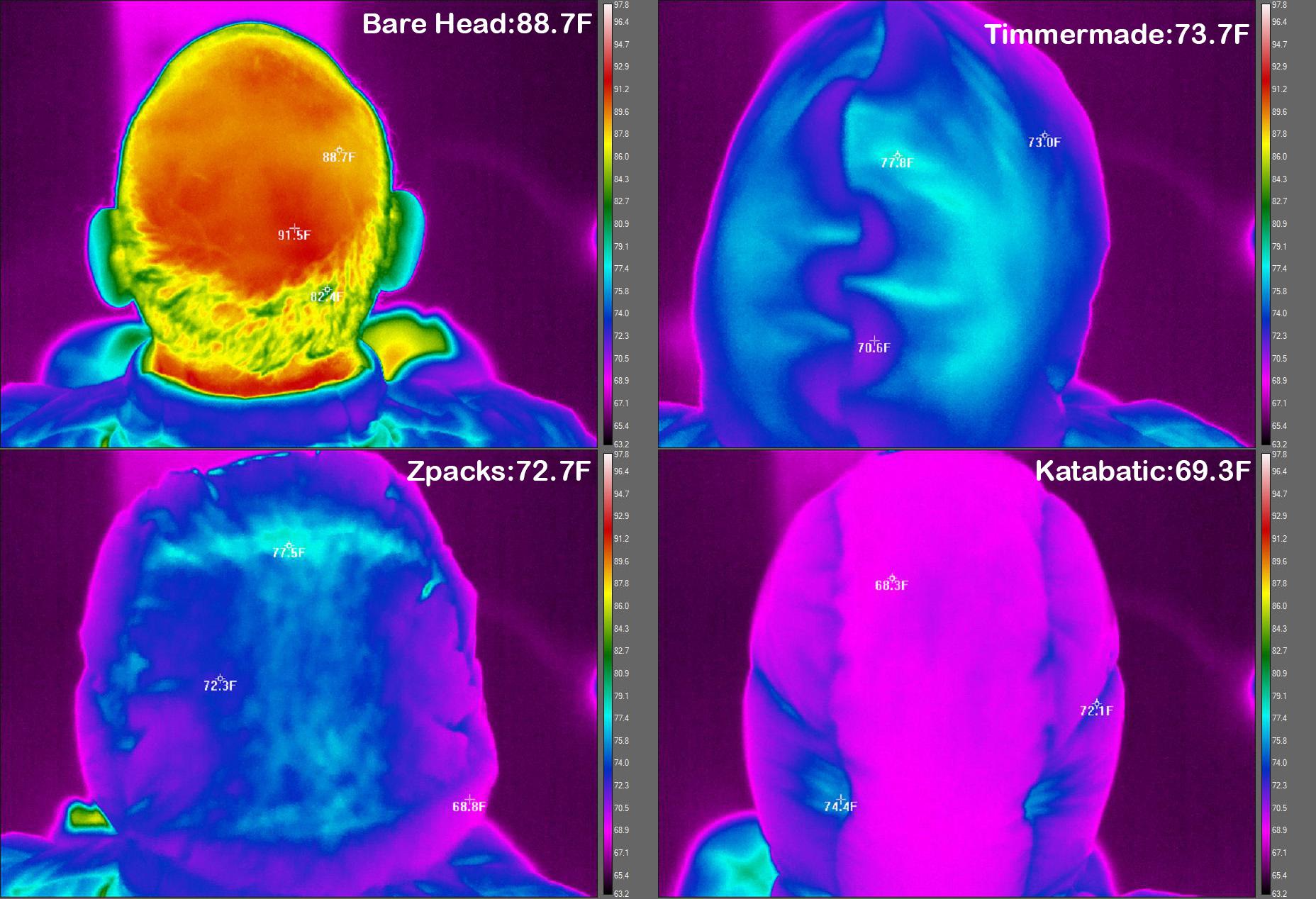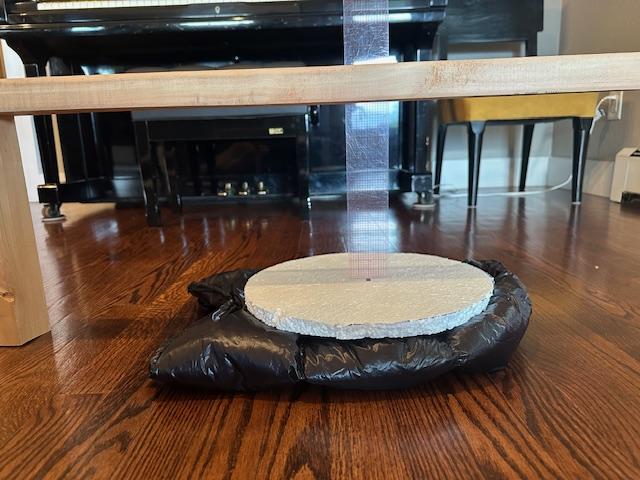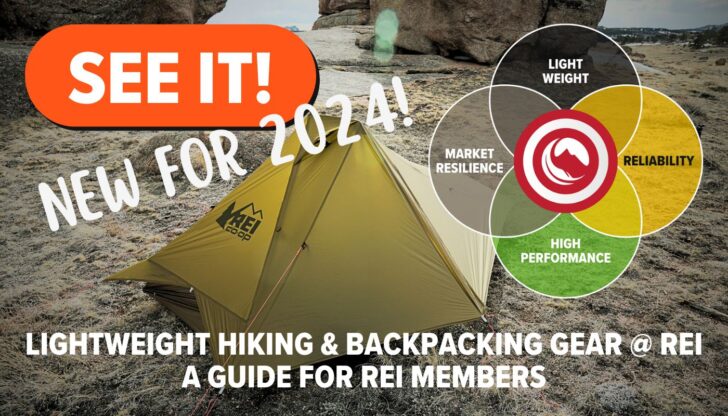Topic
By The Numbers Quickie: Hoodwinked
Forum Posting
A Membership is required to post in the forums. Login or become a member to post in the member forums!
Home › Forums › Gear Forums › Gear (General) › By The Numbers Quickie: Hoodwinked
- This topic has 13 replies, 7 voices, and was last updated 3 weeks, 2 days ago by
 Stephen Seeber.
Stephen Seeber.
-
AuthorPosts
-
May 20, 2024 at 11:21 pm #3811836
Objective: This analysis was conducted to help decide which hood to use in conjunction with my new quilt.
Background:
Problem: When sleeping in a tent, I often get tangled in the hood of my sleeping bag due to my frequent tossing, turning, and side-sleeping.
Solution: I switched to a Katabatic Sawatch 15F quilt, since quilts do not have hoods, and purchased a Zpacks hood to keep my head warm. When the hood arrived, I was concerned it might not be warm enough, so I purchased another to compare.Products Tested:
- Zpacks hood
- Katabatic Crestone hood
- Timmermade Waterbear hood
Methodology:
- Used a thermal imager to capture the temperature of each hood worn on my head.
- Snugged each hood lightly with drawstrings.
- Measured the average temperature of each hood. A lower average temperature indicated better insulation.
- Calculated the approximate R-value (a measure of insulation) for each hood based on my head’s average adjusted temperature and the hood’s surface temperature.


Findings:
The Katabatic Crestone hood was significantly warmer than the others. The other two hoods offered little structural rigidity. As a result, the insulation was compressed and exhibited reduced insulating performance.
Thermal Images Analysis: Timmermade and Zpacks Hoods: Showed a range of temperatures due to insulation being compressed against the head. The vertical “S” shaped stitching line in the Timmermade hood, where insulation was bunched, provided the most warmth found on the hood.
Katabatic Hood: Displayed more uniform temperatures with little evidence of insulation compression. The central baffle running from the forehead to the back of the neck and side baffles are packed with down, providing increased structural integrity and allowing little down compression when in use.
Conclusion: I will include the Katabatic hood in my gear for the next cold-weather camping trip.
May 21, 2024 at 7:58 am #3811841Good info, thanks. I keep trying to find a good solution for this
What do you think of the underarm straps on the katabatic? That seems weird, but maybe a good idea
One thing I don’t like about a hood like that is it’s hard to get on and off. I probably have to take off my glasses.
And if it’s too warm you can’t open it up and ventilate. If it’s really cold this wouldn’t be an issue.
May 21, 2024 at 10:11 am #3811849Wow, I am somewhat surprised that there is so much variation. I sort of expected hoods to all be about the same. Thanks for the report.
Jerry: I have a tunnel hood (for high wind) that straps under the arms. It allows me to pull back the hood (and remain attached) as though it were attached to my jacket. This seems like the main difference between a hood and a hat — the fact that it is always “there” when you want it.
May 21, 2024 at 10:18 am #3811850I normally wear a fleece watch cap.
One problem is over night, sometimes the hat slips up so it no longer covers my ears.
I’ve thought about adding a chin strap.
May 21, 2024 at 10:38 am #3811853It is “heads “above the others !
thom
May 21, 2024 at 11:28 am #3811857I have a MLD 2oz Apex balaclava (large) and a Zpacks down hoody (one size). The MLD is warmer and has a few design details I like better like the face opening bungee organizer and I don’t have to worry about the MLD getting wet. I bring it if I know I will be using the hood to sleep in. I bring the Zpacks if I don’t anticipate needing a hood but want to bring one as insurance. The Zpacks packs tiny, has super durable insulation, and even if the R value is lower than the MLD it still offers a huge amount of cozy warmth compared to a beanie. The Zpacks fits a little better, but I think that is because I would have been better off with the medium size in the MLD rather than my large.
The straps going under the armpits are critical to the hood’s function. It’s like pad attachment straps for your quilt. It allows the hood to follow rotisserie sleepers and keeps your nose pointed out the face hole.
Puffy sleeping hoods rule.
May 21, 2024 at 5:39 pm #3811894Hi Jerry: I have not worn the Katabatic hood yet. I am hoping it is cold enough to use on a trip I am taking on Thursday. I will let you know how the straps work. I wear glasses and the hood goes on and comes off without interference. The hood has a pull cord to tighten the hood around your face. The hood does not obstruct my glasses when snugged. That is not the case with the other two hoods. In terms of warmth, I usually bring several different head/face coverings and use whatever combination is needed for the temperatures. I don’t think I would use this hood, which is pretty warm above 25F or 30F.
May 21, 2024 at 8:46 pm #3811898Warbonett uses a reverse differential cut design to direct loft into your head and eliminate dead air space.
I would be curious to see how the Warbonett bad weather bonnet performs if you ever have the chance to test one
Excellent as usual. This data can be extrapolated to other hoods as well assuming similar insulation level.
May 21, 2024 at 9:45 pm #3811899Hi Bill, It’s kind of amazing that the Katabatic is nearly 3x warmer than the Zpacks hood. The Zpacks fabric is extremely light. I think the quantity of down in the Zpacks is far less than what is present in the Katabatic. Down warmth is all about loft. It is a bit challenging to measure loft of a hood without destroying it. But, here is what I obtained using my ASTM F1932/F1932M device for measuring Sleeping Bag loft. The device consists of a wood frame with a slot through which a ruler is inserted and rests on a disk cut to specified diameter and weight. It is shown here with the Zpacks hood.

I know what you are thinking: pretty sophisticated.
The doubled loft of the Zpacks is 2.12″, while the doubled loft of the Katabatic is 3.75 inches. The Katabatic has a substantial advantage in loft. As I mentioned above, when in use, the Katabatic structure is more robust than that of the Zpacks, so the Katabatic hood maintains its loft better under pressures produced by conforming to the head shape under the pressure from the snugged drawstring.
I think the Katabatic baffles are overstuffed, making the structure more resistant to compression or down migration than the Zpacks hood. Another compression difference appears to be a combination of fabric properties and down density. The air permeability of the Zpacks hood is 4.16 CFM/Ft2, while the air permeability of the Katabatic hood is .68 CFM/Ft2. When subjected to pressure from movement, the Katabatic hood will resist dumping warm air through its fabric better than the Zpacks hood. When pressing on the baffles for the two hoods, the difference in air permeability is apparent. The Zpacks hood may eliminate vapor better than the Katabatic due to its higher air permeability. I cannot make this measurement for a hood, but perhaps I can get a sense of this from use. The Waterbear SUL is designed to solve the problem of cold air contact on your face while sleeping. Its fabrics are designed for very high air permeability. The breath tube can be adjusted to completely cover your nose and mouth and the extreme air permeability of the tube (509 CFM/Ft2) permits most breath vapor to escape. Any vapor that condenses on the breath tube fabric is easily dried. The air permeablity of the hood body is 28 CFM/Ft2. You can see this good has very different design goals than the other two hoods.
May 22, 2024 at 9:38 am #3811939That’s an excellent addition to your article above, giving more detail on differences in design and construction. I can see how the Timmermade and the Katabatic might each have ideal use cases.
I know what you are thinking: pretty sophisticated.
You read my mind. :) Simple tests have the advantage of easy repeatability. Is that a ceiling tile cut to what? A square foot? That is a test that anyone can do, and it might give more real-world results than simply measuring unweighted loft.
I’ve noticed the difference in loft-resilience between different down qualities, fabric, and overstuffing. My Ghost Whisperer is ultralight, but it can’t stand the weight of even a light windshirt over it without losing some of its loft. A $20 AliExpress knock-off is more resilient, although a few ounces heavier. The knockoff has cheaper down, but more of it. Both are similar in unweighted loft.
May 22, 2024 at 9:41 pm #3811972Simple test: To measure the loft of your sleeping bag under the ASTM F1932 standard, you need a 12″ disk and the ruler, as you see in the photograph. The weight of the ruler and disk, together, must be 50 grams.
In lightweight garments, I think loft resilience is critical. With 1000 fill power down, such as in the Mont Bell Plasma 1000, the loft is easily influenced by a variety of influences. I suspect gravity could be one. I doubt that the thermal resistance measured on a horizontal guarded hot plate for this jacket will be the same when worn since I think gravity and pressure from movement would impact the insulation distribution and dimensions in the baffles. In the Zpacks hood, if I hold it up to a light and look through a baffle, I will see light at the top seam of the baffle. If I flip it 90 degrees, I can see light through the new top of the baffle. The insulation has moved in response to gravity. You have to ask yourself how down overstuffing increases warmth. Is it by adding stability so the down doesn’t move around and lose heat every time the trapped air is disturbed? Certainly, as you stuff more down into a baffle, at some point, the amount of air trapped per volume of feather will decrease, and the down becomes less efficient. But these speculations are getting off-topic.
May 23, 2024 at 9:24 am #3812012the reason to overstuff is like you observed – prevent any gaps where there is no down. I’ve done 30% but if I make another garment I might do 50%.
Independently from this, a few years ago Richard Nisely showed some data that showed that if you overstuff 0%, down has twice the warmth per weight of synthetic like apex. Any down you add after this (overstuff) adds warmth per weight at the same level as synthetic. Up to 250% overstuff (or was it 250% stuff – 150% overstuff – I forget). Beyond that it doesn’t add any warmth. Linear approximation.
My explanation is that if you start adding down plumes to a constrained volume, they’ll be closer together which impedes air flow through the plumes so they add some warmth, but not as much as if the plumes are as far apart as gravity allows.
For example, if your quilt had 12 ounces of down and was overstuffed 0%, and it was just warm enough for your needs, how much down would you need if you decreased the baffle volume so it was overstuffed 50%? x * 0.66 + x * 0.33 / 2 = 12. x = 14.5 ounces – you’d have to add 2.5 ounces more down to provide the same warmth as 12 ounces of down if you overstuffed 50%. For 30% you’d have to add 1.6 ounces of down.
Is it worth adding 1.6 or 2.5 ounces of down to avoid shifted down in baffles? I don’t know, maybe this is more aesthetic, maybe some baffles that have a small empty volume, it wouldn’t decrease the over-all warmth much.
If you’re talking about a jacket, it has less down total, so there would be less increased weight if you overstuff.
May 23, 2024 at 11:15 am #3812019Just like how our bodies need varying insulation levels for varying temperatures, our heads also require corresponding variable insulation for those temperatures. Essentially what we have here is analogous to a 50f APEX quilt, a 40f down quilt, and a 20f mummy bag. They aren’t really like items, and we probably wouldn’t compare them together. We would compare a 50 to a 50, 40 to a 40, etc. It is understood that the likely reason for this comparison is that there is often only one choice for hood temp rating, but it should be pointed out that, for the reasons stated, the Waterbear comes in six different variations, with the one used in this comparison intentionally having the least insulation and the least coverage of the six options.
The variations of Waterbears look like this….
SUL Waterbear category – jacket-like hood that can be worn for active use but doubles as sleep hood. Less coverage, breathing tube likely to sit on face rather than hold a pocket of warm air, but stays with head better for active use. Weighs a little less than regular version.
<p style=”text-align: right;”>
– SUL Waterbear APEX variation- 2.5oz/yd2 APEX, minimal insulation level. Meant to add over a hat or whatever other daytime active insulation is being used.</p>
<p style=”text-align: right;”>
– SUL Waterbear Down variation – 1.5″ calculated loft – warmer than APEX version, but more susceptible to loft loss from moisture.</p>Regular Waterbear category- designed as a sleep hood that creates a warm air pocket to breathe. Better coverage and warmth for sleeping, with a looser fit.
<p style=”text-align: right;”>
– Waterbear APEX variation – 2.5oz/yd2 APEX, minimal insulation level. Meant to add over a hat or whatever other daytime active insulation is being used. Same insulation level as SUL version, but better coverage and more room for air pocket.</p>
<p style=”text-align: right;”>
– Waterbear Down (0 – 20f) variation – Box chamber down construction in the body. APEX breathing tube. Temp rating assessed for static sleep use so a huge step up in warmth from the versions above</p>
<p style=”text-align: right;”>
– Waterbear Down (-10 to 10) variation – Box chamber down construction in the body. APEX breathing tube. Temp rating assessed for static sleep use so a huge step up in warmth from the SULs and regular APEX. About a 35% increase in calculated loft, baffle height, and measured loft over the 0 – 20 version.</p>
<p style=”text-align: right;”>
– Waterbear Down (- 10 to really cold) variation – Box chamber down construction in the body. APEX breathing tube. Temp rating assessed for static sleep use so a huge step up in warmth from the SULs and regular APEX. About a 35% increase in calculated loft, baffle height, and measured loft over the (-10 to 10) version.</p>May 23, 2024 at 11:42 am #3812020Hi Dan, Thanks for your comments. I agree with your points about the need for different insulation levels and that the Waterbear I included is the least warm of the hoods you offer. It will probably perform better than any hood out there for vapor transmission, which is critical to its design objective. Despite being your least warm offering, it is about as warm at the Zpacks hood, but with the added feature of providing a warm air pocket over your face through which you can breath.
-
AuthorPosts
- You must be logged in to reply to this topic.
Forum Posting
A Membership is required to post in the forums. Login or become a member to post in the member forums!
New Gear Guides:
Shop the REI Anniversary Sale May 17-27 • “Our Biggest Sale of the Year…”
Our Community Posts are Moderated
Backpacking Light community posts are moderated and here to foster helpful and positive discussions about lightweight backpacking. Please be mindful of our values and boundaries and review our Community Guidelines prior to posting.
Get the Newsletter
Gear Research & Discovery Tools
- Browse our curated Gear Shop
- See the latest Gear Deals and Sales
- Our Recommendations
- Search for Gear on Sale with the Gear Finder
- Used Gear Swap
- Member Gear Reviews and BPL Gear Review Articles
- Browse by Gear Type or Brand.







